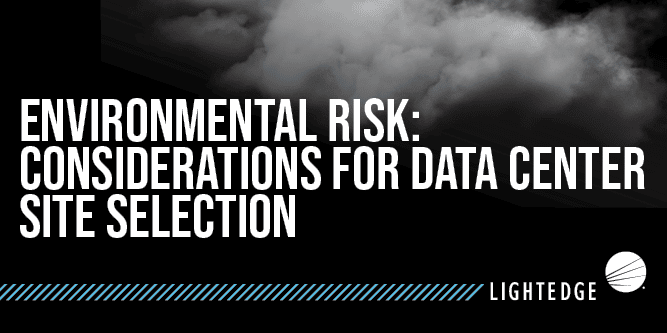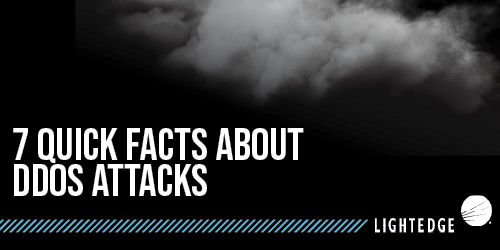A Look Ahead at 2019: 6 Predictions for Lightedge & Our Industry
January 3, 2019

Lightedge
Author

2018 proved to be a big year for Lightedge and the data center & cloud hosting industry. We welcomed OnRamp into the Lightedge family during our 2018 summer acquisition. We expanded two of our data centers to accommodate the growing needs of our customers. Last but not least, we honed in on what we do best, which is offering enterprises secure and compliant cloud and colocation services.
Having experienced one of the best years yet as a company in 2018, Lightedge is looking forward to what 2019 will bring. While we get ready to tackle the unknown, there are a few things we are confident will remain the same. For example, we know that compliance and security will continue to be a top priority with rapidly evolving requirements across all organizations, regardless of industry or size. As such, Lightedge’s service offerings will continue to raise the bar with the top audit standards across the globe. We will also continue to provide unparalleled expert support, and the hybrid flexibility needed to compete in today’s unpredictable market.
We’ve identified a few other trends that we are anticipating for the new year. Much of what we hope to see in 2019 has been hinted at in research or emerging trends, plus we will be making logical assumptions and conclusions based on past evidence from our 20+ years in this space. Here are our 6 predictions for 2019.
1. Data Center Growth Will Continue
In the past year alone, Lightedge has begun expansions on two of our data center facilities (Kansas City, MO & Omaha, NE) to accommodate for the rapid demand we are seeing in our markets. Data centers are not dying. There are more computing demands now than ever. The latest Cisco Visual Networking Index indicates some interesting trends going into 2021:
- Annual global IP traffic will reach 3.3 zettabytes by 2021. In 2016, global IP traffic was 1.2 ZB per year or 96 exabytes (one billion gigabytes) per month.
- Global IP traffic will increase nearly threefold over the next five years and will have increased 127-fold from 2005 to 2021.
With the emergence of wanting flexibility across a variety of cloud options from private to public to hybrid, data centers are evolving to meet these changing needs. Data center facilities are becoming more versatile and powerful, which is why we will see continued growth in 2019.
Lightedge’s data centers run workloads where they perform best, and we never compromise on security. Our facilities show versatility by allowing customers to mix and match services to their exact needs and offer the flexibility to adapt environments as they wish. Our owned and operated facilities, integrated disaster recovery solutions, and premium cloud choices make up true Hybrid Solution Centers that are highly connected for tenants to mix customer-owned computing platforms with Lightedge’s compliant cloud services. We also bring a direct private connection to a variety of public clouds.
A new survey by AFCOM, the data center and IT management education company, found 58 percent of survey respondents currently own between two and nine data centers and that on average, 5.3 data centers will be renovated per organization. That number increases to 7.8 data centers over the course of 12 months.
Redundancy of power and cooling will also continue to grow in importance. All of Lightedge’s facilities are concurrently maintainable and built to Tier III standards. That means they’re designed to offer N+1 redundancy on every main component, providing greater protection and security for your critical IT operations with no downtime. This research and past evidence show that data centers are far from dead, but they are also not staying the same.
2. Cybersecurity Earns its Spot at the Executive Table
2018 was a big year for cybersecurity breaches. Some of the biggest 2018 cybersecurity breaches included Facebook, T-Mobile, and British Airways to name a few. It seemed like every week there was a new breach making the headlines and a different company notifying customers that their data has most likely been compromised.
Data breaches can occur as a result of numerous reasons. Enterprises are hacked, data is mishandled or sold, and inadequate security systems leave information unprotected. Whatever the reason might be, cybersecurity will earn its spot at the executive table in 2019 as a result of previous years’ hard lessons learned. Not only will a loss of private client and business information cost businesses financially, executives must also be cognizant of the irreparable harm to relationships and reputation of the brand.
It is no surprise that this year, cybersecurity concerns will be a major topic amongst the C-suite of every significant enterprise. Cybersecurity is no longer just an IT concern. The major breaches from 2018 has incited fear into CEOs and other officers thinking that their company could be next.
Ponemon Institute’s The State of Endpoint Security Risk Report pegs the average cost of a single attack at $5 million, with $1.25 million—a quarter of the total—attributable to system downtime, and another $1.5 million (30 percent) to IT and end user productivity loss. When the cost of a breach threatens the existence of a company, executives tend to act quickly.
In 2018, the worldwide spending on information security products and services reached more than $114 billion, according to Gartner. This was a 12.4 percent increase from 2017. Gartner is now predicting that in 2019, the market is forecast to grow 8.7 percent to $124 billion.
As the damages from breaches continue to become direr, responsibility for cybersecurity failures will go beyond the CIO and directly to the CEO or President. We predict that many executive meetings will revolve around mitigating cybersecurity risk, response planning, and improving the organizations overall security posture. Cybersecurity will be a hot-button concern starting from the top down like never before.
3. Ransomware Tapers Off, But Continues to Cause Chaos
According to Kaspersky’s KSN Report: Ransomware and malicious cryptominers 2016-2018, the number of people who encountered ransomware in 2017 and 2018 fell by nearly 30 percent over the 2016 to 2017 period. While the number of users impacted by ransomware is on the decline, the disruption it continues to cause can be crippling to enterprises.
The Kaspersky report found that the reason for the decline is because cyber criminals are finding other ways to generate revenue. Cryptojacking and other malicious schemes have proven to make more money. That is reflected in the 44.5 percent rise in number of users that have experienced a cryptomining attack in the past year, according to Kaspersky.
While ransomware activities are falling across the world, they continue to pose a threat and should be treated as such. Criminals behind mobile ransomware are still targeting major organizations and capitalizing on their market choice.
Here are a couple of ways to prevent ransomware attacks in the new year:
- To protect your environment, continue to educate staff and IT teams on how to keep sensitive data safe and always back up everything
- Restrict access to only those who need it to complete their job
- Use application control to track malicious activity
- Always keep software updated on every device that is being used on
- Treat email attachments or messages from unknown people with caution. When in doubt, contact your internal IT team for guidance and do not open it.
4. Multi-factor Authentication Becomes the Standard
As the scope of data breach threats start to grow, organizations that process credit card payments must adhere to PCI DSS rules. The Payment Card Industry Security Standards Council (PCI SSC) is a global organization that maintains, evolves and promotes Payment Card Industry standards for the safety of cardholder data worldwide.
As of last year, the PCI DSS 3.2 framework multi-factor authentication deadlines went into effect. This new tier of compliance adds another level of multi-factor authentication security. These requirements must be applied to all parties with out of network access into the cardholder data environment.
Though multi-factor authentication is far from a perfect solution, most online services are predicted to abandon password-only access and offer additional required authentication methods.
When it comes to implementing multi-factor authentication in the retail industry, here are some best practices for a seamless experience.
- Implement it everywhere: MFA is most effective when it is applied across the board. This means in a company’s cloud applications, on-prem applications, services, resources, etc.
- Use MFA in addition to Single Sign-on: Increase security by implementing MFA in addition to single sign-on because it will eliminate the need for multiple passwords
- Test and monitor frequently: Your MFA policy should be up-to-date and tested for vulnerabilities regularly. Engaging IT or a third-party to test this will lower the risk for a breach.
5. A Shortage of Skilled Technical Workers will Continue
As organizations continue to center around cloud computing, cybersecurity, and colocation, we also expect to see a lack of skilled workers entering the workforce as the older generation starts to retire. Specialized technical skills are in high demand and in short supply.
According to recent estimates, there will be as many as 3.5 million unfilled positions in the industry by 2021. Security engineers and technical workers are becoming harder to find as breaches are on the rise.
Companies need to start broadening their range when seeking potential candidates. While a job seeker may not meet all the qualifications, organizations should plan to provide training opportunities to help educate a new pool of technical experts.
According to the 2017 Global Information Security Workforce (GISW) Study, two-thirds of its nearly 20,000 respondents indicated that their organizations lack the number of cybersecurity professionals needed for today’s threat climate.
Thankfully, Lightedge has a dedicated team of experts on staff with extensive experience working with IBM i (AS/400 / iSeries), AIX, zCloud/mainframe environments, dedicated disaster recovery solutions, cybersecurity, and compliant cloud and colocation solutions.
As your specialized technical workers start to consider retirement, Lightedge is here to help manage your legacy platforms and act as an extension of your IT team.
6. Multi-Cloud Model Replaces One-Size-Fits-All Approach
According to research from Ovum, while 20 percent of business processes have already moved to the cloud, 80 percent of mission-critical workloads and sensitive data are still running on-premises because of performance and regulatory requirements. As many enterprises move into the next phase of their cloud journey in 2019, most will avoid the one-size-fits-all cloud computing approach.
While the public cloud can be cost effective in some situations, not every workload is a candidate for the public cloud. A hybrid multi-cloud environment uses a combination of on-premises, private cloud, and public cloud architecture, with best-in-class resources from secure and compliant vendors.
Making a full transition to the cloud can be a difficult jump for most. With a hybrid cloud solution, companies can transition at their own pace, with less risk. We predict that in 2019, more companies will select a hybrid cloud approach that will allow for more efficiency and effectiveness to each specific business. Lightedge has designed every one of our data centers as highly interconnected Hybrid Solution Centers anticipating this demand. Our clients can integrate customer-owned computing platforms with Lightedge’s compliant cloud services, plus gain a direct private connection to public cloud environments. Our experts are here to talk through your business goals and make sure you have the right blend of clouds for your unique needs that are flexible and scalable.
The 2016 State of the Cloud Survey from RightScale indicates that a business using the cloud will access at least six different clouds. These clouds could be multivendor systems or a blend of private and public clouds. From there, CIOs and IT teams can gain a better understanding of the advantages and disadvantages of each cloud services. From there they can make a decision that best suits their business goals.
How Lightedge Can Fit Into your 2019 Technical Resolutions
No matter what your organization’s technical focus is this year, Lightedge is ready to help. Whether you’re making the move to the cloud, wanting to find a secure hybrid solution center to host your infrastructure, or you’re needing guidance when it comes to security and compliance, Lightedge has you covered.
When it comes to compliance and security, Lightedge’s highly-trained compliance and security experts take the guesswork out of keeping your business protected. Trust our expertise to ensure you are covered through our security and compliance services, including risk management, information security, audit preparedness and support. Learn more about our industry-specific compliance expertise. Our services are compliant with:
- HIPAA and HITECH
- PCI DSS Compliance
- SOC 1, SOC 2, and SOC 3
- ISO 27001 Certification
- ISO 20000-1 Certification
Is 2019 the year you move to the cloud? If you’re already there, have you found the right cloud services that meets your specific business needs? From a dedicated physical infrastructure to a virtual delivery model, Lightedge has the compliant cloud and hosting solution for your organization. Retain the level of control you want, and the amount of data isolation you require.
As a top-tier colocation services provider, we provide a high level of availability and reliability through secure, certified data centers and dedicated staff onsite. Our customized and scalable services give you the control, whether you need a colocation rack, cage or custom suite now or in the future. Get started today with a free quote from one of our colocation specialists.
If you need help getting started with your 2019 technical resolutions, contact one of our experts to get started or to schedule your private tour of any of our seven data centers. We have security, compliance and cloud experts standing by to answer any of your questions.


